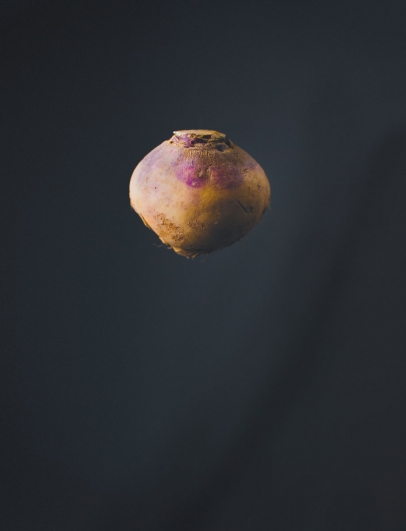A Guide To Eating Local: Rutabagas, Cabbages and Turnips! Oh My!
Tucked away in the produce section of many grocery stores and local markets, often sitting next to other less-recognizable vegetables such as kohlrabi or celery root, sits the Brassica napus, commonly called rutabaga.
For many shoppers this is a mystery food, a little-known member of the vegetable family that is a cross between the turnip and cabbage. The term rutabaga is a variation of the word rotabagge, a Swedish name for ram root. In most areas of the world this vegetable is called a “swede,” or yellow turnip, but here in our country we have given it the title of rutabaga.
The rutabaga is a member of the cabbage family and at first glance resembles an odd-shaped turnip. It is a little larger at the base than its counterpart, with a dark purple band at the crown, a lumpy irregular shape and tan skin. The outer skin of a rutabaga is usually coated with wax to prevent moisture loss.
It may be used in recipes as a tasty alternative to the turnip. Shoppers often confuse the two vegetables, although rutabagas are sweeter and do not taste as peppery as turnips. Their inside flesh has a yellow-orange color with a dense texture similar to that of the turnip. However, its flavor is more intense and hints of the sweetness of cabbage. The rutabaga’s leaves are entirely edible with a mild flavor and soft texture much like turnip greens.
When selecting your rutabaga, make sure you choose one that is firm and smooth-skinned, as well as solid to the touch. It should feel heavy for its size, with the root and stem ends intact. Avoid those that are soft or have wrinkled skin or cracks. If you lean toward the theory that larger is better, the rutabaga you select may be tough and woody with less sweetness. Choose a medium-sized “swede” whenever possible.
Having a lower water content than turnips enables rutabagas to stay fresher longer. Place the unwashed vegetable in an airtight plastic bag and store in the coldest section of the refrigerator, where it will keep for up to three weeks. If not refrigerated, it will last for about a week.
Rutabagas grow best in cool conditions and are considered a “cool season” crop. Their flavor is intensified by a light frost. Fall is the peak season for rutabagas, which continues into the early winter months. Originally from northern Europe, rutabagas were one of the few fresh foods available to the general population after World Wars I and II. A constant diet of rutabagas caused people to tire of eating the vegetable, and they soon became associated with poverty and starvation, gaining the unpopular title of “famine food.”
They are now primarily grown in the northern United States, Europe, Great Britain and Canada. It takes approximately 90 days for them to reach full size. This versatile vegetable may be eaten raw or cooked. As the outer skin is often waxed, use a paring knife to make the peeling process easier.
Rutabagas can be baked, roasted, braised, steamed, stir-fried, microwaved and boiled. When boiling, follow this helpful tip: Lift the lid to release the gases, which have an unpleasant odor. Releasing the gases causes the rutabaga to taste better. There are a variety of ways to introduce this flavorful vegetable to your family or guests. Cook them with potatoes, either roasted or mashed; add them to stews and soups; or use as a delicious addition to salads. They add a unique taste when grated into coleslaw or a carrot salad. Adding cinnamon, minced garlic or lemon juice enhances their flavor.
Rutabagas are high in antioxidants. The vegetable’s most significant nutrient is vitamin C, and one cup contains 53% of the recommended daily requirement. To make measuring easier, think of a cup of cubed vegetables as being equal to the size of your fist or a baseball. Rutabagas are low in sodium, saturated fat and cholesterol and are an excellent source of dietary fiber, thiamin, vitamin B6, calcium, magnesium, phosphorus and potassium. One cup of cubed rutabagas contains about 66 calories. All of these factors help to promote health throughout the body.
Rutabagas even found a place in the Guinness World Book of Records when in 2011 Ian Neal, a gardener in the UK, produced the world’s largest “swede.” His rutabaga weighed 85.5 pounds! After his win Ian brought his giant vegetable to a local farm to use as fodder for the livestock. The leaves of rutabagas make great winter feed for animals.
Some well-known varieties of rutabagas found around the world include the American Purple Top, Joan, Laurentian, Marian, Heirloom and Gourmet rutabagas, which are prized for their exceptional taste. It seems as if folks are really beginning to sit up and take notice of this odd shaped little root vegetable. They are relatively inexpensive, so the next time you are in the grocery store, search out a Brassica napus. Surprise your family with a new addition to the menu. Both you and those at your dinner table are in for a real treat!




